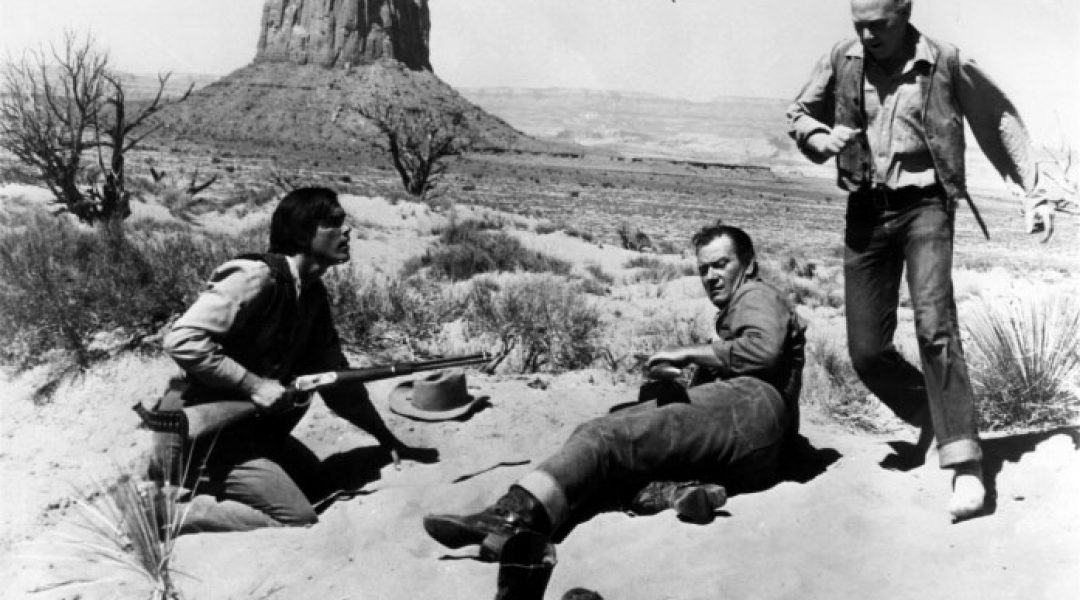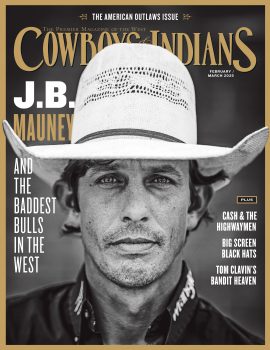Here's our all-star round up of best westerns according to C&I readers, film critics, and big stars.
Note: This is our original list published in January 2002. After nearly 20 years, we decided it was way past time for an update. Check out the revised list that appeared in our July 2021 issue here.
1. The Searchers (1956)
It would be impossible to come up with a unanimous No. I, with thousands of films and a century to span, but is there anyone who loves Westerns who doesn’t love The Searchers? John Ford may have written the language of the movie Western in Stagecoach, but with The Searchers he demonstrated a mastery of visual storytelling to craft a film that is the cinematic equivalent of the Mona Lisa. Unheralded in its time, The Searchers has become an icon for those who take their movies seriously. Francis Ford Coppola, George Lucas, Steven Spielberg, and Martin Scorsese rank it among their most profound cinematic influences. Even moviegoers who have never been to film school debate the film’s best camera shots.
If that makes watching The Searchers sound as exciting as attending a classroom lecture, nothing could be further from the truth. Ethan Edwards’ seven-year search for his niece, who is kidnapped by Indians, has the dramatic sweep of epic poetry. The embittered, bigoted Edwards undertakes an inner search for grace that mirrors his journey through Monument Valley. The quests end simultaneously, as Edwards, who had planned to kill the girl rather than see her raised as a savage, lifts her triumphantly into the air and lovingly cradles her in his arms, uttering four words that make Western fans cry: “Let’s go home, Debbie.”
But there is no home for Ethan. He’s seen too much, done too much, to ever be accepted into polite society. In the classic final scene, Ethan returns Debbie to her family but cannot cross the threshold of their cabin. He remains outside, framed in the doorway, destined to wander his live-long days devoid of the comforts of home and hearth.
John Wayne’s uncompromising portrayal of one of the movies’ most ferocious tragic heroes should have earned him an Academy Award. But it would be more than a dozen years before Wayne finally hooked up with Oscar for his portrayal of Marshal Rooster Cogburn in True Grit (No. 60).
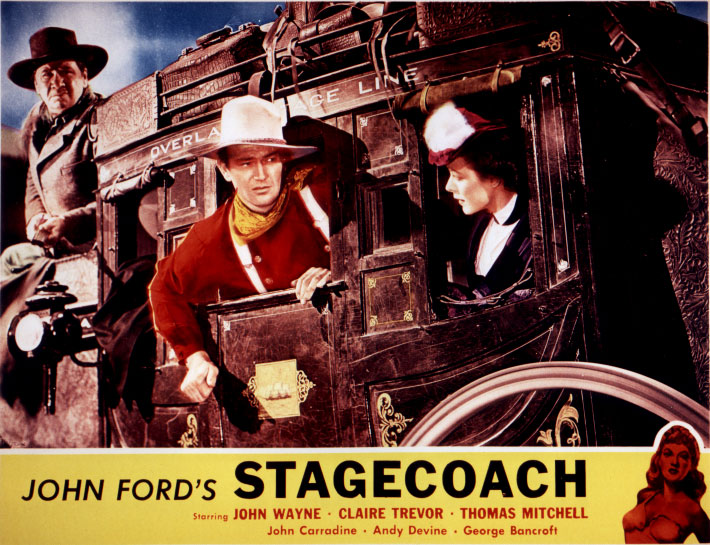
2. Stagecoach (1939)
Hailed upon its release as a touchstone in the evolution of the Western, Stagecoach is ostensibly a straightforward tale of eight passengers traveling through hostile territory. But beneath the surface, Dudley Nichols’ literate script examined the conflicting dynamics between the characters — male and female, North and South, high-brow and low-brow, valiant and cowardly — and the fascinating ways in which those dynamics change during the journey.
John Ford’s decision to cast John Wayne did not sit well with producer Walter Wanger, who wanted Gary Cooper. But as Stagecoach became a template for the genre, The Ringo Kid established the John Wayne persona: a strong, independent man who lives by a moral code that doesn’t always conform to the law of the land. He is respectful toward women, but awkward and timid when it comes to romance. Ringo’s marriage proposal to the prostitute Dallas (Claire Trevor), delivered with head bowed and voice wavering, is a kind of quiet, poignant moment not found in Westerns before Stagecoach.
John Wayne’s entrance scene seems to have been deliberately designed to introduce a significant new presence in the genre, as the long shot from the moving stagecoach closes rapidly toward a figure in the distance. Wayne forces the stagecoach to a halt. He stands, legs apart, a saddle slung over his shoulder, twirling his customized Winchester. “Looks like you’ve got another passenger,” he tells driver Andy Devine, and western movies would never be the same.
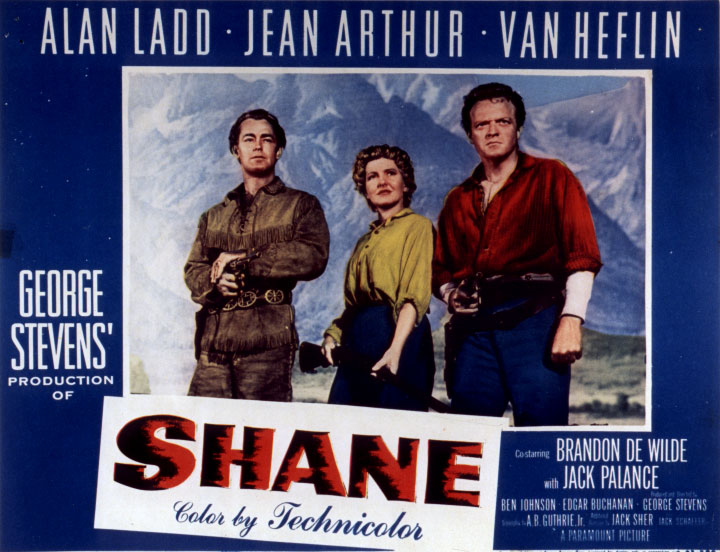
3. Shane (1953)
Shane is not just a story of the West; it’s all the stories of the West: ranchers vs. homesteaders; the taming of the frontier; the showdown between good and evil; and the gunfighter who protects law and order (Alan Ladd), then feels out of place once the job is done.
Younger viewers tend to experience Shane through the eyes of Brandon De Wilde and share his hero worship of the buckskin-clad stranger with the pearl-handled revolver. Shane is soft-spoken and polite (“I hope you don’t mind my cuttin’ through your place”), but his hair-trigger response to a sudden noise betrays his identity as a gunfighter. Alan Ladd may have stood only 5’4” but to little Joey (De Wilde) his presence is larger than life.
When these same viewers grow up and come back to the film, they see the emotional layers in the adult relationships, which add greater resonance to the story. Marian (Jean Arthur) warns Joey about getting too attached to Shane, but clearly she’s trying to warn herself. Her husband Joe (Van Heflin) recognizes her attraction as well as the way his son idolizes Shane, but he does nothing, hoping Shane will do the right thing when the time comes.
Every scene works, every performance rings true. Director George Stevens turns the removal of a tree stump into a moment of exhilaration. The smiles Shane and Joe exchange when they turn the tide in their general-store brawl arc irresistibly infectious. Jack Palance, as the embodiment of evil, set a standard for western villainy that is yet to be surpassed. And De Wilde’s plaintive cries of “Come back, Shane!” at the fade-out still echo in the memory.
4. My Darling Clementine (1946)
The title provides the first clue to John Ford’s intent. Although My Darling Clementine was based on Wyatt Earp’s dubious biography, Frontier Marshal, and follows the events leading up to the gunfight at the OK Corral, Ford concentrated on the romance between Wyatt (Henry Fonda) and Clementine (Cathy Downs). It is fitting that the gunfight, though exciting, doesn’t come close to being the most memorable scene in the film. The quieter moments — the church dance, the hilarious hair tonic scene, Doc’s Shakespearean soliloquy — are most indelible. This is the most beautiful black-and-white western ever made. In fact, it’s worth watching once with sound off to better appreciate the chiaroscuro created by cinematographer Joseph MacDonald.
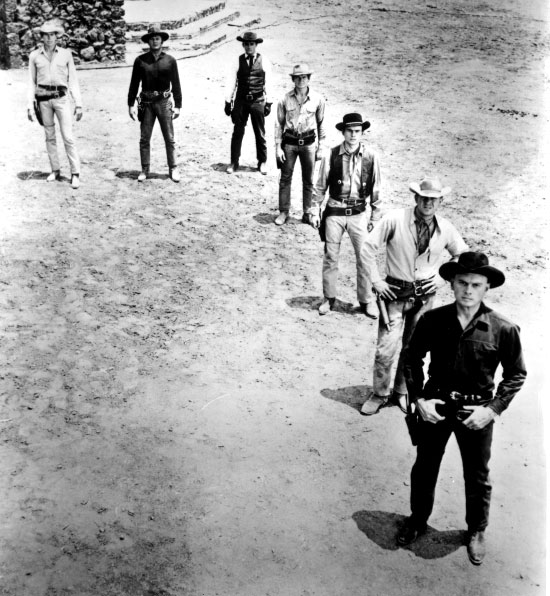
5. The Magnificent Seven (1960)
It’s on TV all the time — TBS, AMC, TNT — the Food Network and Animal Planet are probably next. And if it pops up during a channel surf, you can’t turn it off whether it’s near the beginning, when Yul Brynner recruits his team of mercenaries, or when the “Seven” ride into the Mexican village, to the pulse-quickening “Bomp-BUMP-Bump-Bomp” of Elmer Bernstein’s score, or at the film’s climax during the crackerjack shootout with the vicious raiders led by the demonic Calvera (Eli Wallach). It’s based on Akira Kurosawa’s The Seven Samurai, but this is no high-brow museum piece. Whereas the previous four films on this list are justly lauded as cinematic art, The Magnificent Seven has no pretensions other than to being the ultimate cowboy popcorn movie.
6. Lonesome Dove (1989)
It was a western at a time when no one else was making them. It was six hours long, when the national attention span had shrunk to the length of a Madonna video. It starred fifty-something Robert Duvall and forty-something Tommy Lee Jones, when television advertisers cared only about the youth market. And it was produced by Motown, and that made no sense at all. But in 1989, for four nights in February, it seemed as if everybody was watching Lonesome Dove. Larry McMurtry’s story of two retired Texas Rangers and their conversations and adventures during a cattle drive sought to “strip the glamour from the Old West.” But it was also a celebration of friendship, loyalty, and endurance of hardship, virtues long associated with the genre.
7. High Noon (1952)
No classic western divides movie fans more than High Noon. Carl Foreman, a blacklisted screenwriter, based the film on personal experience, hence the cold shoulder Marshal Will Kane receives when he asks his community for help. John Wayne and Howard Hawks were outraged that Kane would try to recruit amateurs into his fight and made Rio Bravo to remind moviegoers how the West was won. But the public loved High Noon, with its vulnerable hero (Gary Cooper, who won the Best Actor Oscar), lovely newcomer Grace Kelly, and haunting theme song. The film was taut and suspenseful, its story told on the faces of its characters and with the relentless ticking clock.
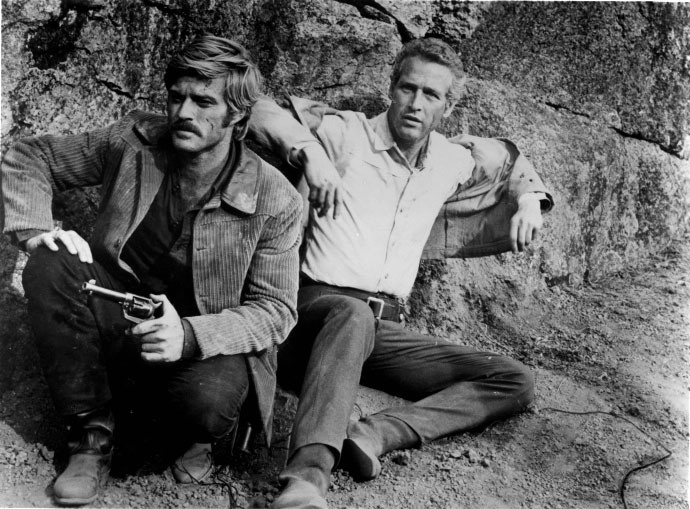
8. Butch Cassidy and the Sundance Kid (1969)
“Not that it matters, but the following story is true.” William Goldman’s “history with a twist” formula mixes fact and legend to create a high-spirited adventure. Butch and Sundance may not have been as glib or good-looking as Paul Newman and Robert Redford, but Goldman’s script stayed close to the facts as they’re known, and if Butch and Sundance didn’t really jump off that cliff to escape a posse, they should have. Redford and Newman’s potent chemistry inspired legions of attempts at imitation. The duo single-handedly gave birth to the “Buddy Film,” and the enduring influence of Butch Cassidy and the Sundance Kid can be found in movies as diverse as 48 Hours and Shanghai Noon.
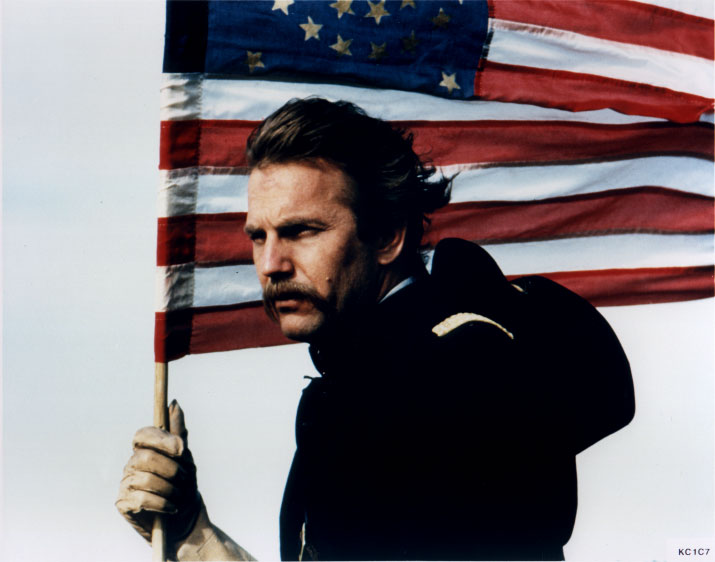
9. Dances With Wolves (1990)
We knew, we always knew, even while cheering for the cavalry in countless films, that history is written by the winners of the world’s conflicts, and America’s Native population got a raw deal. With Dances With Wolves, we finally saw the other side of the tale, and how fitting that it was through the eyes of an American soldier. Dances With Wolves became a personal crusade for Kevin Costner, who coproduced, directed, starred, and raised financing overseas after a string of Hollywood studios passed. His passion was rewarded with seven Academy Awards and an awakening of our national conscience.
10. The Outlaw Josey Wales (1976)
It was the movie Clint Eastwood had to make, before the impassive persona he created through the Sergio Leone films and his other signature character, Dirty Harry, became a typecasting trap. In his 1976 book The Filming of the West, movie historian John Tuska predicted that Eastwood’s career likely didn’t have staying power. That same year, The Outlaw Josey Wales introduced a new type of Eastwood character, still quiet, still deadly, but also compassionate and emotionally vulnerable. The title describes how society will judge Josey Wales — an outlaw only by circumstance — but when his quest is complete, he returns to being the farmer Josey Wales in a scene that offers hope for the future.
11. Gunsmoke (1955 – 75)
Even those who would relegate TV westerns to a status beneath their movie counterparts — and we know we’ll be hearing from you — must acknowledge the greatness of Gunsmoke. The series spanned two of the most defining decades in American pop culture history, from Marilyn Monroe to Farrah Fawcett; from “Rock Around the Clock” to “The Hustle;” from The Searchers to The Godfather. Through it all there was James Arness as Marshal Matt Dillon, tall in the saddle and afraid of nothing, except maybe marriage to Miss Kitty.
12. Destry Rides Again (1939)
Has there ever been a more unlikely romantic pairing than Jimmy Stewart’s laid-back, milk-drinking lawman Tom Destry and Marlene Dietrich as the bawdy singer with a German accent and the inexplicable name of Frenchy? Destry Rides Again packs memorable songs (Dietrich’s “See What the Boys in the Back Room Will Have”) and memorable scenes (a ferocious catfight between Dietrich and Una Merkel) into 94 flawless minutes. The movie would have been longer if certain lines had made it past the censors, such as when Dietrich wins a poker hand and drops the coins down her blouse, prompting a cowboy to quip, “There’s gold in them thar hills.”
13. Rio Bravo (1959)
Knowing Rio Bravo’s connection to High Noon affords insight into an interesting slice of Hollywood history, but it’s hardly a prerequisite to enjoy its rousing mix of action, comedy, romance, and music. Dean Martin and Angie Dickinson join old hands John Wayne and Walter Brennan, and if the casting of Ricky Nelson was a blatant attempt by Howard Hawks to boost the box office with teenage girls, at least the kid contributed a fine duet with Martin on the ballad “My Rifle, My Pony and Me.” And look on the bright side; it could have been Fabian.
14. The Gunfighter (1950)
“The fastest man with a gun who ever lived ... was a long, lean Texan named Ringo.” We’ve seen gunfighters as heroes and villains, lawmen and mercenaries. But Jimmie Ringo (Gregory Peck) is the gunfighter as celebrity; trapped by fame, a subject of gossip, scorn, and adulation, Ringo can’t order a drink in a bar without drawing attention. “He don’t look so tough to me,” sneers any number of envious punks. Famous last words.
15. Red River (1948)
Red River appeals to those moviegoers who don’t like westerns, but inevitably discover that, yes, John Wayne can act and, yes, movies about cowboys and cattle drives can be about more than cowboys and cattle drives. Allusions to Mutiny on the Bounty infuse the father-son conflict between Wayne and Montgomery Clift, and their climactic fistfight symbolizes their genuine “old Hollywood vs. young Hollywood” rivalry. The happy ending divided audiences, but the director, Howard Hawks, liked both characters too much to let either perish, and it’s hard to fault his decision.
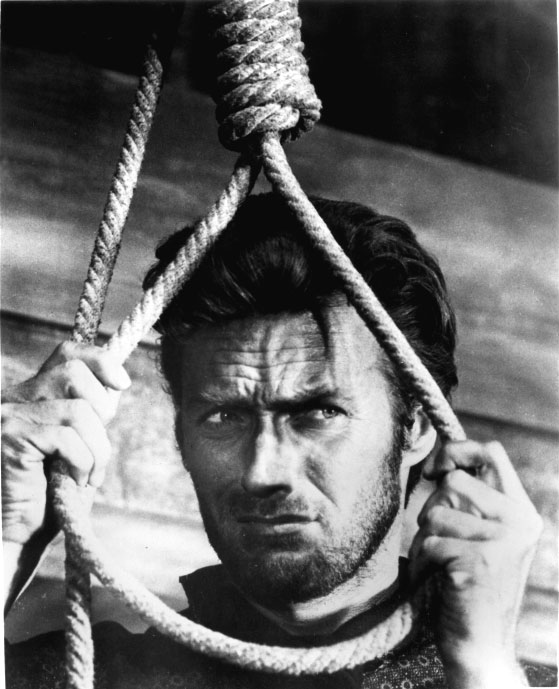
16. The Good, the Bad, and the Ugly (1967)
Recent scholarship has favored Once Upon a Time in the West as Sergio Leone’s crowning work, but for those who can’t separate the Leone oeuvre from its most famous character, The Good, the Bad, and the Ugly is the ultimate spaghetti western. It has all the signature elements: dusty, desolate vistas; amoral characters such as Tuco (Eli Wallach) who are motivated only by profit; a showdown in a circular arena, suggesting gladiators in a colosseum; an incomparable score whose whistling theme, by Ennio Morricone, is instantly recognizable; and Clint Eastwood as the serape-clad, cheroot-chomping Man with No Name.
17. One-Eyed Jacks (1961)
This film never stood a chance back in 1961, when its star and director, Marlon Brando, spent three years fussing over every camera angle and line reading. Word got out that Mr. New York actor was making an artsy western, and One-Eyed Jacks was released to a combination of frosty reviews and public indifference. Today, the back story forgotten, we treasure this deceit-filled saga of two old partners in crime, one revenge-obsessed but still capable of redemption, the other hiding a savage nature behind a sheriff’s badge. For Gen-Xers who know Brando only as the roly-poly guy who kissed Larry King, here’s proof that once upon a time, he was cool off the charts.
18. The Wild Bunch (1969)
The best opening credits sequence ever ends with William Holden growling “If they move ... kill ’em!” followed by the sepia-toned freeze-frame “Directed by Sam Peckinpah.” Kinda says it all. The director’s original 144-minute cut was trimmed almost immediately after the film’s release, but it’s been restored for the video and DVD release. The new scenes deepen the connection between Pike (Holden) and former Bunch member Robert Ryan, now a bounty hunter on Holden’s trail, and after 30 years we finally discover how Pike got that limp.
19. The Man Who Shot Liberty Valance (1962)
Rance Stoddard (James Stewart) plays a pitifully meek attorney incapable of killing sadistic outlaw Liberty Valance. But that’s what history has recorded because “when the legend becomes fact, print the legend.”’ Lee Marvin gives us a wonderful villain for the ages, and John Wayne impersonators picked up a staple for their act in the Duke’s demeaning references to Stewart’s character as “Pilgrim.”
20. The Great Train Robbery (1903)
Two western-style shorts were actually created before The Great Train Robbery was produced: in 1898, Thomas Edison filmed the five-minute sequences Cripple Creek Bar-room and Poker at Dawson City. But it was The Great Train Robbery, a reenactment of a heist by the ever-popular Butch Cassidy and his Wild Bunch only a few years earlier, that signifies the true beginning of the western.
21. The Shootist (1976)
We remember it sadly, and the truth is that we shouldn’t. Though it’s impossible to disconnect fact from fiction when E.W. Hostetler (Jimmy Stewart) tells John Bernard Books (John Wayne), “You’ve got cancer” (Wayne succumbed to the disease in 1979), no movie star essayed a better final bow. With his performance in The Shootist, the Duke delivered one last valentine to his fans (and costar Lauren Bacall), one last raspberry to his critics, and an elegy to the American West that — to paraphrase Andrew Sarris — represents the survival of certain vestigial virtues in an era of mealy-mouthed relativism.
22. Once Upon a Time in the West (1969)
Henry Fonda never struck us as the bad-ass type, but in Sergio Leone’s operatic follow-up to his Dollars trilogy, Fonda plays one of the most abhorrent hired guns ever. It’s disturbing, like watching Mr. Rogers give a kid a wedgie. Forty minutes of cuts killed the original American release, but the film was finally restored to its full grandeur in 1984.
23. She Wore a Yellow Ribbon (1949)
“So here they are, the dog-faced soldiers, the regulars, the 50-cents-a-day professionals, riding the outposts of the nation.” The middle entry in John Ford’s Cavalry trilogy had his stock company at their most sentimental and featured Oscar-winning photography of Monument Valley in Technicolor. The Duke, whose inherent air of authority worked to his favor when he played older characters, found one of his most indelible roles as retiring officer Nathan Brittles.
24. Unforgiven (1992)
Has it really been almost 10 years since this film won the Academy Award for Best Picture and Clint Eastwood garnered Best Director honors? In order to bring life to this project, Eastwood traded on his status as the genre’s last bankable star to get a western made in a youth-driven market, then crafted a darkly poetic character study that found more to condemn than to celebrate in our western myth. When anyone over 60 wins an Oscar, the assumption is that it’s a career award. The highest compliment one could pay Eastwood and Unforgiven is that no one even thought to ask.
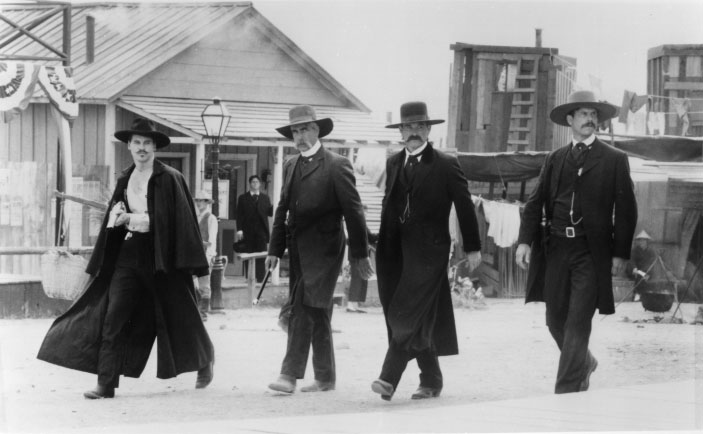
25. Tombstone (1993)
Most people discovered Tombstone after it went to video. As the “other” Wyatt Earp movie, it was overshadowed by Kevin Costner’s epic biography, but Tombstone’s unpretentious, balls-out gusto reminded us that a great western didn’t have to unfold on the grand scale of Lonesome Dove or Dances With Wolves. Kurt Russell looks remarkably like the real Wyatt, and Val Kilmer’s unforgettable take on Doc Holliday is the best genre performance by an actor in the past 20 years. Strap on the guns again, Val — we’ll be your huckleberry.
26. The Lone Ranger (1949 – 57)
He wore a black mask and a white hat, a confusing combination. But children always knew he was a friend. Few characters in western fiction are as beloved as the Lone Ranger and Tonto, as played by Clayton Moore and Jay Silverheels. The inspired teaming of a cowboy and an Indian was a paradigm of racial harmony. And to this day, we can’t listen to the “William Tell Overture” without thinking “Hi-ho, Silver!”
27. The Virginian (1929)
We’ll smile when we say it — no western novel has been dramatized more than The Virginian. It had been filmed twice before Gary Cooper played the tide role in the first “talking” feature-length western. Subsequent versions appeared in 1946 and 2000, and a TV series debuted in 1962 and ran for nine years. But it’s Cooper’s Virginian we remember, for his star-making turn and the mustache-twirling of the villainous Walter Huston.
28. Winchester ’73 (1950)
What’s amazing about Anthony Mann westerns is how each of his characters are fully developed, from Will Geer’s folksy take on Wyatt Earp to the barkeep on the job at his saloon. Winchester ’73, the story of “the gun that won the West,” follows Jimmy Stewart as he traces the provenance of his stolen rifle through a series of unsavory owners, all of whom are brought down by frontier karma.
29. Blazing Saddles (1974)
The western was in trouble in the 1970s, so when Blazing Saddles rode into theaters, fans wondered if it signified a genre revival or the last nail in its coffin. Ten years later, it was still the highest-grossing western in history. Mel Brooks’ rude, crude masterpiece contained enough laugh-out-loud moments for 10 movies, from the infamous campfire scene to Madeline Kahn’s show-stopping send-up of Marlene Dietrich.
30. Fort Apache (1948)
Moviegoers were used to seeing the U.S. Cavalry ride to the rescue, battle trumpets blaring. John Ford wanted to take a more in-depth look at a typical regiment; the day-to-day work of soldiers in remote outposts, their personal lives, and how they cope with the constant threat of attack. Fort Apache inaugurated the landmark Cavalry trilogy with a sobering reminder that sometimes the good guys don’t win.
31. Angel and the Badman (1947)
Can a man who lives by the law of the gun walk a more enlightened path? Quirt Evans (John Wayne), on the vengeance trail, must choose between killing the man who murdered his father and settling down with a sweet farm girl played by Gail Russell, the hottest Quaker babe in movies. An underrated entry in the Wayne canon.
32. City Slickers (1991)
Crowd-pleasing comedy that resonated with middle-aged baby boomers. A trio of Big Apple buddies (Billy Crystal, Daniel Stern, and Bruno Kirby) join Jack Palance’s cattle drive, and discover the one secret of life. Palance won the Oscar for Best Supporting Actor, and a calf named Norman became the most beloved bovine since Ferdinand.
33. Dallas (1978 – 91)
The corporate cowboys in the television series Dallas rode around in Mercedes-Benz coupes and held their showdowns in glass and steel skyscrapers. Not exactly a traditional Western, but beneath the soap-opera excess, the Ewings were ranchers who fought among themselves but always circled the wagons against an outside threat. OK, Bobby’s season-canceling shower was a cop-out. But J.R. Ewing was the most famous cowboy in America for more than a decade, and when he was shot the whole world wondered whodunit.
34. The Naked Spur (1953)
Jimmy Stewart plays a ruthless bounty hunter who, when told his captive is innocent, replies, “It’s him they’re payin’ the reward on.” Robert Ryan is superb as the manipulative villain who tries to sever the uneasy alliance between Stewart and the companions who joined him on the trail. Another intense psychological drama from Stewart and Anthony Mann.
35. The Big Trail (1930)
Director Raoul Walsh cast John Wayne in The Big Trail on the advice of John Ford, who said he “liked the looks of the new kid with a funny walk,” Wayne went from extra to star, which would have been a great discovery story had the film been a hit. But The Big Trail still deserves to be seen, not just for Wayne’s early-career work but for its remarkable wide-screen panoramas and near cinéma vérité action scenes, including a river crossing in a fierce storm that almost drowned the cast.
36. Oklahoma! (1955)
As long as the wind still comes sweeping down the plain, we’ll never grow tired of spending time with Curly and Laurie and Ado Annie, and listening to “Oh, What a Beautiful Morning,” “Surrey with the Fringe on Top,” “People Will Say We’re in Love,” and the rest of Rodgers and Hammerstein’s splendid Oklahoma! score.
37. A Fistful of Dollars (1964)
Henry Fonda, James Coburn, and Charles Bronson passed on the chance to play a nameless drifter in a Western reworking of the Japanese film Yojimbo. Director Sergio Leone settled for TV actor Clint Eastwood, who cashed a $15,000 paycheck for the movie that made him an international star. Eastwood wisely deleted most of his lines from the script to augment the drifter’s mythic persona.
38. The Wild, Wild West (1965 - 70)
A gadget-filled train, a megalomaniacal dwarf, and Robert Conrad in very tight pants. Secret Service Agents James West (Conrad) and Artemus Gordon (Ross Martin) were TV’s original dynamic duo in this spoofy, action-packed western. One rerun will expunge any memory of the awful 1995 movie of the same name.
39. The Man From Snowy River (1982)
To say that it’s Australia’s contribution to the western isn’t much of a compliment. (There’s not much competition.) But The Man From Snowy River captured the mythic spirit of the West as well as any homegrown product has, perhaps because it was based on a revered Australian legend. We’ve seen horses gallop across a vast expanse a thousand times. Snowy River made those scenes inspiring again. Critics shrugged; audiences fell in love.
40. The Ox-Bow Incident (1943)
With the exception of its opening sequences, The Ox-Bow Incident was shot almost entirely with painted backdrops and artificially created light and shadow. The closed-in feeling suits this dark story of a lynching of innocents and its repercussions among the town folk.
41. The Man From Laramie (1955)
Quintessential Anthony Mann drama starring the director’s favorite obsession-driven cowboy, James Stewart. In their final collaboration, Stewart hunts down the men who sold guns to the Apaches, resulting in the death of his brother. If Shakespeare had written a western tragedy, it might have looked like this.
42. Blood on the Moon (1948)
Moody and very dark, more film noir than horse opera, with Robert Mitchum as a long-haired drifter caught between warring ranchers and homesteaders. Mitchum, a shifty character in any setting, plays moral relativism so well that even when he does the right thing, you still don't trust him.
43. Duel in the Sun (1946)
Gone With the Wind, western-style. Gregory Peck and Jennifer Jones steam up the Arizona desert in jaw-dropping Technicolor. Producer David Selznick promises “a picture of a thousand memorable moments.” Audiences dubbed it Lust in the Dust. Melodramatic, over-the-top, and just plain trashy — but in a good way.
44. Will Penny (1968)
“It takes a heap takes of time, years to build up a spread. I don’t have them ... years no more.” A noble cowboy at twilight, beautifully photographed by Lucien Ballard and played by Charlton Heston in one of his most understated performances. Too bad moviegoers preferred to watch him fighting dirty apes in another 1968 film.
45. 3:10 to Yuma (1957)
A companion piece to High Noon, with a more charismatic villain. Someone has to watch captured outlaw Glenn Ford until the 3:10 train, but nobody wants the job except a desperate farmer (Van Heflin), who needs the $200 reward to feed his family. A tense psychological drama.
46. Rio Grande (1950)
The final entry in John Ford’s majestic Cavalry trilogy, and the first teaming of John Wayne and Maureen O’Hara, a match made in movie heaven. Lines of mounted soldiers in Monument Valley never looked more inspiring, but the best moment remains when the regiment serenades O’Hara with “I’ll Take You Home Again, Kathleen.”
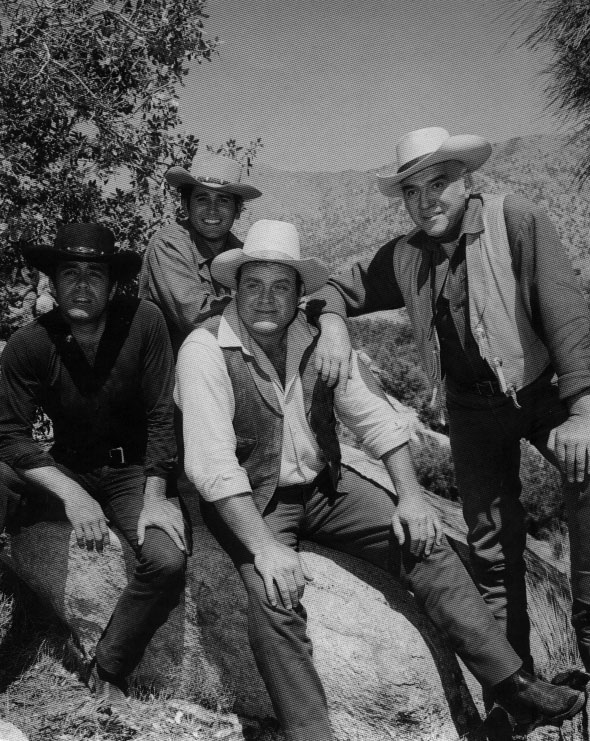
47. Bonanza (1959 – 73)
For 14 years, the adventures of Ben Cartwright and sons Adam, Hoss, and Little Joe were a Sunday night tradition. Stories dealt more with family than heroes and villains, but they didn’t flinch from such serious topics as drug abuse and racial prejudice. It’s a good thing these four guys had each other (and Hop Sing, of course), because girlfriends on the Ponderosa had an alarmingly short life expectancy.
48. Gunfight at the O.K. Corral (1957)
Burt Lancaster plays Wyatt Earp and Kirk Douglas plays Doc Holliday, and that’s pretty much all you need to know. This is the best of the two stars’ many collaborations, especially with Rhonda Fleming, one of the top western actresses, along for the ride. The climactic gunfight is a knockout.
49. El Dorado (1967)
Sometimes magic happens by accident. El Dorado seemed an exercise in going through the motions; an unofficial finale to a trilogy of Howard Hawks westerns (Rio Bravo and Rio Lobo came first) all starring John Wayne, in which the stories were more or less interchangeable. But Wayne, Robert Mitchum, and James Caan play the familiar material with a wink to each other and to the audience that is irresistible.
50. High Plains Drifter (1972)
This was Clint Eastwood’s first western as both star and director, and it brought new meaning to the phrase “paint the town red.” Eastwood essays another no-nonsense man of few words, but his scenes with pint-sized costar Billy Curtis offer unexpected comic relief.
51. Support Your Local Sheriff (1969)
No one played the reluctant hero better than James Garner, whose easygoing charm fit perfectly in this delightful comedy.
52. Have Gun Will Travel (1957 – 63)
At a time in TV history when every other show was a western, viewers still hadn’t met a character like Paladin (Richard Boone), the suave, sophisticated gun-for-hire with the chess knight calling card.
53. Cowboy (1958)
A Chicago hotel clerk bails a cowboy out of debt, in exchange for a job on his next cattle drive. Terrific East-meets-West discord, personified by Jack Lemmon and Glenn Ford.
54. For a Few Dollars More (1965)
Clint Eastwood’s Man with No Name meets Lee Van Cleef, Man with No Facial Expression. Violence ensues.
55. Annie Get Your Gun (1950)
Often overlooked among the great MGM musicals, Annie Get Your Gun has an extraordinary Irving Berlin score, brassy Betty Hutton as Annie Oakley, and more dancing cowboys than Gilley’s in its heyday.
56. Comes a Horseman (1978)
Superb Gordon Willis photography elevates this post-World War II spin on the old story of independent ranchers under siege from big business.
57. The Sons of Katie Elder (1965)
In, The Sons of Katie Elder, John Wayne and Dean Martin reprise their Rio Bravo chemistry as four brothers track down their father’s killer, with no help from local lawmen.
58. Tumbleweeds (1925)
A landmark silent film starring the screen’s first cowboy hero, William S. Hart. The thrilling land rush scene remains a cinematic tour de force.
59. Maverick (1957 – 62)
Irreverent, non-traditional western with James Garner as the affable Bret Maverick, a gambler who, when trouble beckons, is ever-ready to climb out of a window and run away.
60. True Grit (1969)
The Duke finally walked off with an Oscar as the irascible Marshal Rooster Cogburn. John Wayne called Rooster’s recollections of his life to costar Kim Darby “the best scene I ever did.”
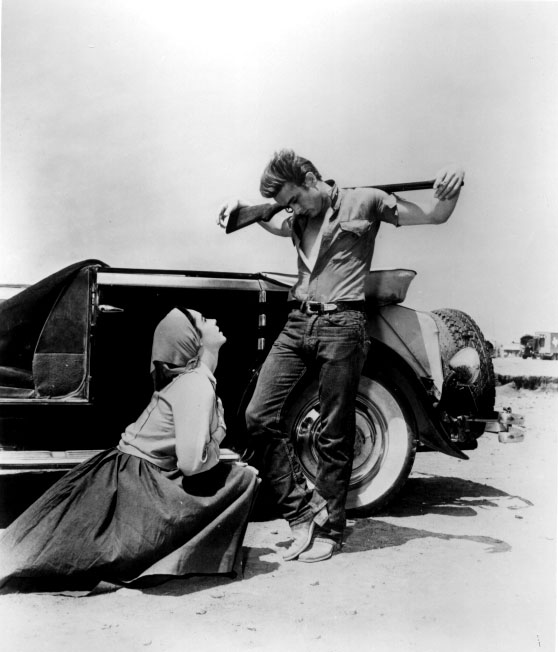
61. Giant (1956)
Director George Stevens won the Oscar for Giant’s amazing visuals, including the iconic image of James Dean, cowboy hat low over his forehead, reclining behind the wheel of a vintage roadster.
62. The Plainsman (1936)
Cecil B. DeMille’s frontier epic about Wild Bill Hickok and Calamity Jane surrounds Gary Cooper and Jean Arthur with 2,500 Sioux and Cheyenne extras. Note the dramatic Star Wars-style credits.
63. Dodge City (1939)
What’s the best barroom brawl in history of western movies? It has to be the donnybrook in Dodge City, starring Errol Flynn, Olivia de Havilland and one condemned saloon.
64. Ride the High Country (1962)
Two western icons, Joel McCrea and Randolph Scott, get back in the saddle for career-capping performances in Sam Peckinpah’s poetic tribute to a disappearing way of life.
65. Wagon Train (1957 – 65)
Long before The Love Boat ever thought of setting sail, Wagon Train gathered different guest stars each week for an eventful expedition. And unlike wagonmaster Ward Bond, Captain Stubing never had to worry about Indian attacks.
66. Alias Jesse James (1959)
Bob Hope runs into outlaw trouble and is rescued by a historic assemblage of Hollywood cowboys, including Roy Rogers, Gene Autry, Gary Cooper, Hugh O’Brian as Wyatt Earp, James Arness as Matt Dillon and Fess Parker as Davy Crockett.
67. The Tin Star (1957)
A sheriff turned disillusioned bounty hunter (Henry Fonda) tutors an inexperienced lawman (Anthony Perkins) in this intense Anthony Mann classic.
68. Rawhide (1959 – 66)
America meets Clint Eastwood as cattleman Rowdy Yates and sings along between whip-cracking to the best TV western theme song ever.
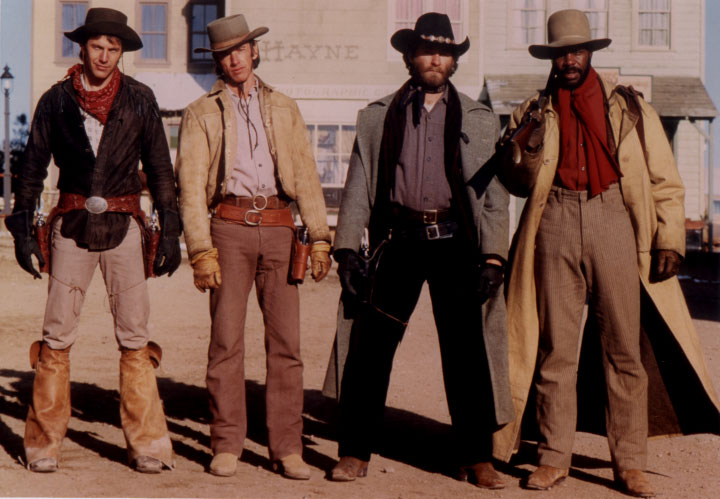
69. Silverado (1985)
An ambitious attempt to revive the old-school western by writer Lawrence Kasdan, who manages to simultaneously salute and send up every cliché of the genre.
70. Cheyenne Autumn (1964)
After portraying Indians as shooting gallery ducks for 25 years, director John Ford switched sides in his final western. Moving, heartfelt, and long overdue, even if the Cheyenne chiefs are played by Ricardo Montalban and Gilbert Roland.
71. 3 Godfathers (1948)
Three Cowboys Find a Baby: John Ford’s take on the oft-filmed story is sentimental in the right way and gave John Wayne a chance to stretch his familiar screen persona.
72. Lonely Are the Brave (1962)
The passing of the Old West was indelibly captured one unforgettable image when fugitive cowboy Kirk Douglas tries to cross a superhighway on horseback.
73. Jesse James (1939)
Pure hokum as a biography of the famed outlaw, but grand entertainment starring Tyrone Power as Jesse and Henry Fonda as his brother Frank and featuring some of the most perilous stunt riding ever captured on film.
74. Warlock (1959)
The provocative undercurrents in this tale of a hired gunslinger (Henry Fonda) and his faithful companion (Anthony Quinn) will keep the Freudians busy for hours.
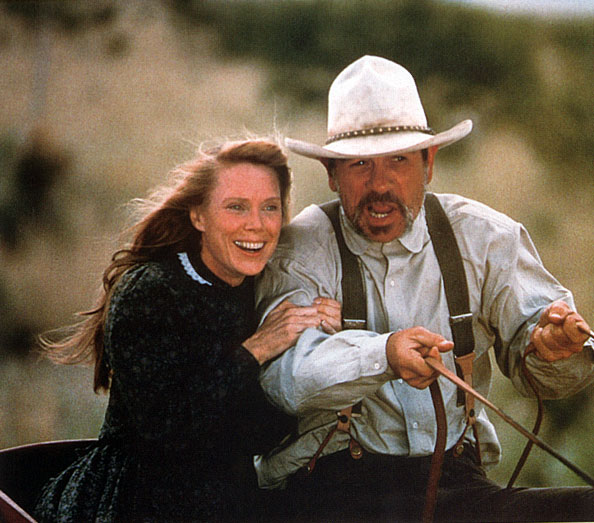
75. The Good Old Boys (1995)
Tommy Lee Jones directs and stars in a tender, humorous TV western with a feature quality cast (Frances McDormand, Sissy Spacek, Matt Damon).
76. Arizona (1940)
Female leads are a rarity in westerns, so it’s a treat to see the talented Jean Arthur pulling off a rootin’ too tin’, shoot-’em-up with only a modicum of support from William Holden.
77. McLintock! (1963)
Copyright complications and a variety of other legal cockleburs kept this comedy featuring John Wayne and Maureen O’Hara out of circulation for decades. We wondered if McLintock! was as good as we remembered, and then it debuted on video. Yes, it was.
78. Cat Ballou (1965)
Jane Fonda plays the title role, a schoolteacher turned bandit, but Lee Marvin steals the film in an Oscar-winning dual role, capped by the funniest rendition of “Happy Birthday” in movie history.
79. McCloud (1971 – 77)
Dennis Weaver portrayed New Mexico Marshal Sam McCloud, who drew snickers from the hard-boiled Manhattan police detectives for his sheepskin coat and cowboy hat, until he beat them to the bad guys every time.
80. The Grey Fox (1982)
Stuntman turned actor Richard Farnsworth waited 40 years for a lead role, and then became an overnight sensation as an aging train robber.
81. The Alamo (1960)
Republic ... we like the sound of that word. John Wayne plays Davy Crockett in a historically honest depiction of the famous siege. Spurned in its time, the film now gets better with every viewing.
82. Two Mules for Sister Sara (1969)
The moral of this story is never pick up a hitchhiking nun. The odd-couple teaming of Clint Eastwood and Shirley MacLaine really clicks.
83. Union Pacific (1939)
Typically bold Cecil B. DeMille blend of history and fiction, with Barbara Stanwyck in one of her best tough-girl roles.
84. Hombre (1967)
Elmore Leonard’s story of a white man raised by Apaches pulls no punches in its condemnation of frontier racism.
85. The Life and Legend of Wyatt Earp (1955 – 61)
Unique among TV westerns in that the continuing story followed the historical life of Wyatt Earp (Hugh O’Brian) to Tombstone, where the saga of the OK Corral unfolded in a five-part series climax.
86. A Big Hand for the Little Lady (1966)
Breezy comedy with a terrific twist ending, with Henry Fonda and Joanne Woodward as a farm couple who risk their life savings in a high-stakes poker game.
87. Barbarosa (1982)
A laid-back outlaw (Willie Nelson) befriends a farm boy on the lam (Gary Busey) in this amiable, well-photographed character study.
88. Trail of Robin Hood (1950)
A holiday classic. Roy Rogers saves Jack Holt’s Christmas tree business with help from an all-star posse of western heroes, including Rex Allen, Allan “Rocky” Lane, and Ray “Crash” Corrigan.
89. Man Without A Star (1955)
Ranch hand Kirk Douglas matches wills with a savvy cattle baroness (Jeanne Crain) while trying to keep the fences away from his corner of the frontier.
90. The Big Country (1958)
Lots of westerns have “Big” in their title. Why this one isn’t more celebrated is a “big” mystery, though it gains new converts with every airing on Turner Movie Classics.
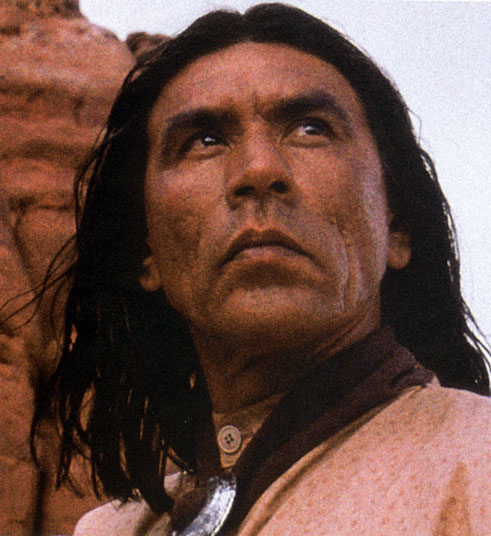
91. Geronimo: An American Legend (1993)
Best of the many film biographies of the famed Apache leader, with a star-making performance from Wes Studi as Geronimo.
92. The Cisco Kid (1950 – 56)
“Hey, Pancho!” “Oh, Ceeesco!” If you didn’t grow up enjoying this exchange every Saturday morning, our profoundest sympathies. Duncan Renaldo and Leo Carrillo played the famed Mexican heroes.
93. How the West Was Won (1962)
Gargantuan screen epic chronicling three generations of a pioneer family. Long but engrossing, with a dozen top stars and one of Alfred Newman’s best scores.
94. High Chaparral (1967 – 71)
Romeo and Juliet on a ranch, with America and Mexico as the contentious families. The marriage of “Big John” Cannon (Leif Erickson) and his Mexican bride, Victoria (Linda Cristal), inaugurated five years of sophisticated stones.
95. Cimarron (1931)
The first western to win the Oscar for Best Picture stars Richard Dix and Irene Dunne as Easterners heading west. Dated, but a vital step in the maturation of the genre.
96. Junior Bonner (1972)
“Bloody Sam” Peckinpah proves he could make a good PG movie with this thoughtful look at rodeo life, with Steve McQueen as an aging bull rider.
97. The Big Valley (1965 – 69)
Barbara Stanwyck had a knack for working well in a frontier setting, and she found her best western role not in movie theaters but in this popular television series that blended good drama with plenty of action.
98. The Phantom Empire (1935)
See! Gene Autry battle torch-wielding robots! Thrill! To the singer’s adventures in the kingdom of Murania! Laugh! At how much fun going to the movies used to be, when serials like this off-the-wall sci-fi western played before the feature.
99. Hang ’Em High (1967)
Clint Eastwood’s first film after the Dollars trilogy has him playing an innocent rancher condemned for murder. Lively attempt at cooking Leone’s spaghetti recipe stateside.
100. The Unforgiven (1960)
Audrey Hepburn in a western is reason enough to watch this one, but this John Huston film also features fine performances from Burt Lancaster and legendary starlet Lillian Gish.
From the January 2002 issue.






